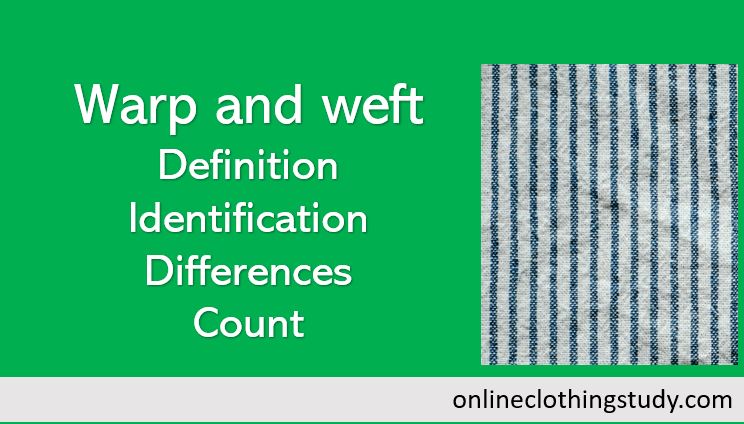
Warp and weft are the very first two terms among many textile terminologies that I learned in my textile classes. Warp and weft are everyday terms in the textile and apparel industry that are used in explaining fabric quality. They are used in drafting fabric designs in textiles.
Learners and newcomers always come with different types of questions related to warp & weft yarns in textile fabrics. In this article, I have explained warp and weft yarns in various aspects to give the reader complete knowledge of these two terms - warp threads and weft threads.
List of contents
- The meaning of warp and weft
- Warp count and the weft count
- Difference between warp and weft yarn
- Synonyms of warp and weft yarns
- Identification of warp and weft yarns in a woven fabric
- Warp and weft in knitting
1. Meaning of warp and weft yarns
Until the yarns are woven into a fabric or going to be used in weaving (in the preparation stage), yarns are called yarns and threads. The yarns can be single-ply yarn, plied yarn, spun yarn, filament yarn, etc. Once the fabric is formed, the same yarn is called an ether warp or weft. Warp and Weft terms are defined below.
Weft - Weft yarns are the set of yarns in woven fabrics that lies horizontally in the fabric and perpendicular to warp yarns (fabric selvage). In a loom, while the fabric is woven, weft yarns move inside the shed of warp yarns. In a traditional loom, the weft yarn is passed over and under the warp yarn by a shuttle. Weft yarns are threaded in a shuttle.
Related post: How to determine warp and weft in a woven fabric?
2. Warp count and the weft count
Warp count means the number of warp yarns used in one inch in a woven fabric. Weft count means the number of weft yarns per inch in a woven fabric. The weight and density of the fabric depending on the warp and weft count.In most fabrics, the warp count remains higher than the weft count.
The warp count is presented in EPI (Ends per inch) and the weft count is presented in PPI (Pick per inch). Fabric warp count and the weft count is one of the important fabric quality parameters. Warp and the weft count are tested in testing labs as part of the FPT in fabric performance tests.
Read this post to learn the method for finding EPI and PPI in a woven fabric.
3. Difference between warp and weft yarns
Now you know, the lengthwise or longitudinal yarns in fabric are warps and horizontal yarns are the weft. To compare these two sets of yarns, we can refer to the following points -- Warps yarns are stronger compared to weft yarns.
- In warp, ply yarns are used. On the other hand, single yarns are majorly used in the weft.
- Warp yarns are finer than weft yarns.
- The weft yarn is inserted over and under the warp yarns.
- Weft yarn can be easily pulled out from the fabric compared to pulling a warp yarn.
- The warp provides the structure for the fabric and is what gives the fabric its strength and form.
Read more such differences in this post
4. Synonyms of warp and weft yarns
The warp and the weft yarns or threads are termed by different names as well. In the trade and academic books, warp yarns are called ends and it is called tana (in Hindi). Weft yarns are also known as filling yarns, Picks, and Bana (in Hindi).5. Identification of warp and weft yarns in a woven fabric
For cutting garment components from a woven fabric, we often need to identify fabric grain (warp direction). Even there are other reasons one needs to identify the warp and weft yarn in a piece of fabric. The fall of the fabric is better in clothes in the warp direction.For counting EPI and PPI using a pick glass one first needs to identify the warp and weft yarn.
Do you like to know how to identify warp/weft in a fabric? Follow the tips explained in this article to identify warp and weft.
6. Warp and weft in knitting
In the above five points, we have discussed warp and weft terms which are related to woven fabrics. The warp and weft terms are also used in the knitting process.
In weft knitting, a continuous yarn is used for forming courses and rows of loops. Weft knitting comes in three fundamental stitches like, plain knit, rib knit, and purl knit. Weft knitting produces both circular as well as flat fabrics.
The warp knitting comes in six stitches Tricot knit, Milanese knit, Simplex knit, Raschel knit, Ketten raschel knit, and crochet knit.
Other terms related to warp
Warp shed - In weaving, the shed is the temporary separation between upper and lower warp yarns through which the weft is woven. The shed is created to make it easy to interlace the weft into the warp and thus create woven fabric. (Source: Wikipedia)Warper beam – A beam is a cylinder having flanges at both sides. Warp threads are wound in a warper beam prior to the weaving process and warp sheet preparation.
